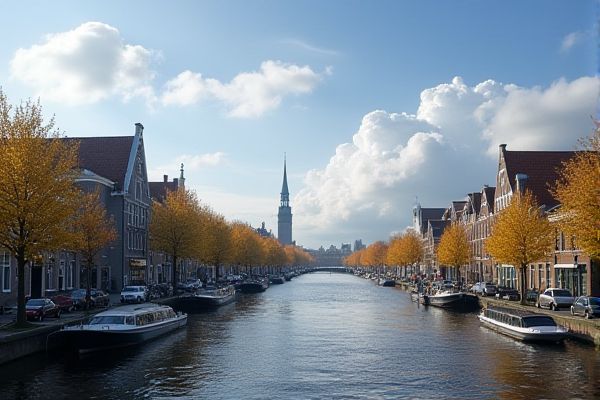
Safety and crime rates in Netherlands: Low overall crime rate. Safe public transportation. Local emergency contact numbers. Pickpocket hotspots: tourist areas. Community policing presence. Reliable crime statistics sources. Active neighborhood watch programs. Strong anti-drug policies. Bicycle theft common in cities. Well-lit urban areas at night.
Low overall crime rate.
The Netherlands has a notably low overall crime rate, with the number of registered offenses falling from 1.35 million in 2005 to 930,000 in 2016, and reaching a record low of 770,000 in 2018. This decline is attributed to factors such as reduced prison sentences, lower rates of pre-trial detention, and effective rehabilitation programs. For a deeper understanding of these trends and the factors influencing the Netherlands' Empty Prisons, comprehensive insights reveal how effective policies contribute to the country's criminal justice success.
Safe public transportation.
Public Transportation in the Netherlands is relatively safe, with an average of 22 road deaths per year involving public transport vehicles, mostly affecting vulnerable road users like pedestrians, cyclists, and moped riders, rather than the occupants of the public transport vehicles themselves. For more detailed insights and updates, you can visit the SWOV website which provides comprehensive information about road safety and related statistics.
Local emergency contact numbers.
In the Netherlands, the primary emergency number is 112 for police, fire, and ambulance services. For non-emergencies, there's a dedicated number, 0900 8844, for reaching the police and 0800 9009 for addressing power and gas issues. Additionally, various other specific numbers exist for different types of emergencies and services, ensuring that residents have access to the appropriate assistance when needed. For more comprehensive information on these critical details, visiting the Dutch Review offers invaluable insights.
Pickpocket hotspots: tourist areas.
In the Netherlands, particularly in Amsterdam, tourist areas such as the Red Light District, Anne Frank House, Vondelpark, Rijksmuseum, and Van Gogh Museum are identified as hotspots for pickpocketing. Similar risks are also present in crowded areas like Dam Square and Amsterdam Central Station. For more insights on staying safe and identifying these risk-prone areas, you can visit the Euronews website. It's crucial for travelers to remain vigilant when visiting such iconic spots to ensure a safe and enjoyable experience.
Community policing presence.
In the Netherlands, Community Policing has been a significant component of law enforcement, with community officers integrated into local communities to enhance safety and crime prevention. Despite variations in implementation, community officers are involved in criminal investigations, emergency services, and intelligence-led policing, and they play a crucial role in early detection and counterterrorism efforts. For more insights on the implementation and effectiveness of this approach, you can refer to the comprehensive analysis available on the Erasmus University Repository.
Reliable crime statistics sources.
Crime statistics in the Netherlands are meticulously documented, offering insight into various facets of criminal activity, such as homicide rates, drug-related offenses, and hate crimes. According to data provided by the Central Bureau of Statistics (CBS), recent figures highlight concerning trends in crime victimization and prosecution. These reliable insights are essential for understanding changes in crime rates and ensuring informed decision-making. Additionally, historical crime rate statistics, compiled from various resources, contribute to a comprehensive view of the annual changes and international comparisons. Platforms such as Statista further enhance this understanding with detailed reports on discrimination and other specific crimes prevalent in the region.
Active neighborhood watch programs.
In the Netherlands, Neighborhood Watch schemes are highly popular and integrated into community safety, with over 700 schemes active in nearly half of the Dutch municipalities by 2016. These schemes, often initiated by citizens or in collaboration with municipalities and police, aim to deter petty crimes and enhance community cohesion. Although their effectiveness in reducing crime is mixed, they face challenges such as the need for clear guidelines and cooperation with local authorities. For more comprehensive information, visit the German National Library website.
Strong anti-drug policies.
The Netherlands has strong anti-drug policies, tolerating the sale of soft drugs in 'coffee shops' under strict conditions, while prosecuting all other forms of possession, sale, or production of soft or hard drugs. The government is also intensifying efforts to dismantle cannabis-growing operations and curb the production and trafficking of hard drugs. For more detailed information on these efforts and policies, you can visit the Dutch Government's official website on drugs.
Bicycle theft common in cities.
Bicycle theft is a significant issue in the Netherlands, particularly in cities like Amsterdam, where 10,920 bikes were stolen in the last year, making it the city with the highest number of bike thefts. Other cities such as Rotterdam, The Hague, and Utrecht also experience high rates of bicycle theft, with an estimated total of over 85,000 bikes stolen nationwide in the last year. For more details, visit the report on NL Times.
Well-lit urban areas at night.
In the Netherlands, crime is highly concentrated in urban areas, particularly in well-lit and densely populated neighborhoods of major cities like Amsterdam, Rotterdam, and The Hague, where higher levels of urbanization are associated with higher crime rates, including property crimes and violent offences. Despite this concentration, the overall crime rate remains relatively low, but certain urban hotspots stand out for their high crime incidence. For more detailed analysis, Prohic offers an insightful article on how Crime Is Unevenly Distributed Across The Netherlands, providing a deeper understanding of the factors influencing crime distribution across these regions.
